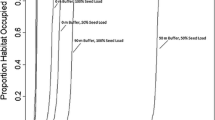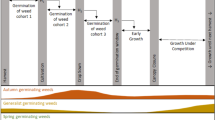Abstract
Widespread adoption of genetically modified glyphosate-resistant (GR) crops in the US has dramatically changed the agricultural landscape to one that selects for establishment and spread of weedy species resistant to glyphosate, a commonly applied herbicide. Weed species that possess the means to readily spread across the landscape will be contained by weed management strategies that limit weed establishment and prevent seed set. An empirically-derived simulation model was developed to explore GR Conyza canadensis spread in relation to characteristics of the agricultural landscape. C. canadensis seeds are carried in the wind and move among fields and therefore, access high quality habitat (GR crops) at long distances. The baseline scenario was the current GR adoption levels in many US agricultural landscapes with corn and soybean rotated annually. Alternate scenarios examined the interacting effects of management uniformity (GR crop adoption) and increased landscape richness (three crops: corn, soybean, alfalfa, instead of two), over a 10 year simulation period. When landscape uniformity increased (increased GR corn adoption), 3× more fields would be infested with the resistant biotype and a specific field would have up to 24% greater likelihood of being infested compared to the current GR crop adoption levels. Increased landscape richness (adding alfalfa as a third crop) slightly decreased GR C. canadensis abundance. Reduced GR management uniformity by way of reducing GR soybeans to half their current adoption levels had the greatest impact on spread and prevented GR C. canadensis from reaching high abundance. Large-scale reliance on glyphosate for weed management has increased high-fitness habitat and will result in rapid spread of glyphosate-resistant weeds. Without significant reductions of glyphosate use and without spatial coordination of weed and crop management practices, GR weeds will continue to spread rapidly and impact agricultural practices in areas reliant on glyphosate.




Similar content being viewed by others
References
Beyer HL (2004) Hawth’s analysis tools for ArcGIS. http://www.spatialecology.com/htools. Accessed 22 November 2006
Bhowmik PC, Bekech MM (1993) Horseweed (Conyza canadensis) seed production, emergence, and distribution in no-tillage and conventional-tillage corn (Zea mays). Agronomy (trends in agricultural science) 1:67–71
Bianchi FJJA, van der Werf W (2004) Model evaluation of the function of prey in non-crop habitats for biological control by ladybeetles in agricultural landscapes. Ecol Model 171:177–193. doi:10.1016/j.ecolmodel.2003.08.003
Brown CM, Whitwell T (1998) Influence of tillage on horseweed, Conyza canadensis. Weed Technol 2:269–277
Bruce JA, Kells JJ (1990) Horseweed (Conyza canadensis) control in no-tillage soybeans (Glycine max) with preplant and preemergence herbicides. Weed Technol 4:642–647
Buhler DD (1992) Population dynamics and control of annual weeds in corn (Zea mays) as influenced by tillage systems. Weed Sci 40:241–248
Carriere Y, Ellsworth PC, Dutilleul P, Ellers-Kirk C, Barkley V, Antilla L (2006) A GIS-based approach for area wide pest management: the scales of Lygus hesperus movements to cotton from alfalfa, weeds, and cotton. Entomol Exp Appl 118:203–210. doi:10.1111/j.1570-7458.2006.00384.x
Cerda H, Wright DJ (2004) Modeling the spatial and temporal location of refugia to manage resistance in Bt transgenic crops. Agric Ecosyst Environ 102:163–174. doi:10.1016/j.agee.2003.08.004
Clark JS, Silman M, Kern R, Macklin E, HilleRisLambers J (1999) Seed dispersal near and far: patterns across temperate and tropical forests. Ecology 80:1475–1494
Coble HD (2008) The role, value, and importance of complementary herbicides for weed management in glyphosate tolerant crops. Proceedings weed science society of America
Dauer JT (2007) From emergence to impact: Conyza canadensis adaptations that facilitate seed dispersal. PhD thesis, The Pennsylvania State University
Dauer JT, Mortensen DA, Humston R (2006) Controlled experiments to predict horseweed (Conyza canadensis) dispersal distances. Weed Sci 54:484–489
Dauer JT, Mortensen DA, Van-Gessel MJ (2007) Temporal and spatial dynamics of long-distance Conyza canadensis seed dispersal. J Appl Ecol 44:105–114. doi:10.1111/j.1365-2664.2006.01256.x
Dauer JT, Mortensen DA, Luschei EC, Isard SA, Shields E, Van-Gessel MJ (2009) Conyza canadensis seed ascent in the lower atmosphere. Agric For Meteorol 149:526–534
Davis VM, Gibson KD, Bauman TT, Weller SC, Johnson WG (2007) Influence of weed management practices and crop rotation on glyphosate-resistant horseweed population dynamics and crop yield. Weed Sci 55:508–516. doi:10.1614/WS-06-187.1
Diggle AJ, Neve PB, Smith FP (2003) Herbicides used in combination can reduce the probability of herbicide resistance in finite weed populations. Weed Res 43:371–382. doi:10.1046/j.1365-3180.2003.00355.x
Dunning JB, Danielson BJ, Pulliam HR (1992) Ecological processes that affect populations in complex landscapes. Oikos 65:169–175. doi:10.2307/3544901
Gonzalez-Andujar JL, Perry JN (1995) Models for herbicide control of the seedbank of Avena sterilis: the effects of spatial and temporal heterogeneity and of dispersal. J Appl Ecol 32:578–587. doi:10.2307/2404654
Gonzalez-Andujar JL, Plant RE, Fernandez-Quintanilla C (2001) Modeling the effect of farmers’ decisions on the population dynamics of winter wild oat in agricultural landscape. Weed Sci 49:414–422. doi:10.1614/0043-1745(2001)049[0414:MTEOFD]2.0.CO;2
Gressel J, Ammon HU, Fogelfors H, Gasquez J, Kay QON, Kees H (1982) Herbicide resistance in plants. Wiley, New York
Gurian-Sherman D (2007) GE crop regulation at a crossroads. Front Ecol Environ 5:231. doi:10.1890/1540-9295(2007)5[231:GCRAAC]2.0.CO;2
Hamilton GS, Mather PB, Wilson JC (2006) Habitat heterogeneity influences connectivity in a spatially structured pest population. J Appl Ecol 43:219–226. doi:10.1111/j.1365-2664.2006.01132.x
Hanski I, Gilpin ME (1997) Metapopulation biology: ecology, genetics, and evolution. Academic Press, San Diego
Heap I (2008) The international survey of herbicide resistant weeds. http://www.weedscience.com. Accessed 06 May 2008
Hilborn R, Mangel M (1997) The ecological detective: confronting models with data. Princeton University Press, Princeton, NJ
Holm L, Doll J, Holm E, Pancho J, Herberger J (1997) Conyza canadensis (L.) Cronq. (syn. Erigeron canadensis L.). World weeds: natural histories and distributions. Wiley, Toronto, pp 226–235
Law R, Dieckmann U (2000) Moment approximations of individual-based models. In: Dieckmann U, Law R, Metz JAJ (eds) The geometry of ecological interactions: simplifying spatial complexity. Cambridge University Press, Cambridge, pp 252–269
Leung B, Bossenbroek JM, Lodge DM (2006) Boats, pathways, and aquatic biological invasions: estimating dispersal potential with gravity models. Biol Invasions 8:241–254. doi:10.1007/s10530-004-5573-8
Levey DJ, Tewksbury JJ, Bolker BM (2008) Modelling long-distance seed dispersal in heterogeneous landscapes. J Ecol 96:599–608. doi:10.1111/j.1365-2745.2008.01401.x
Macdonald DW, Rushton S (2003) Modeling space use and dispersal of mammals in real landscapes: a tool for conservation. J Biogeogr 30:607–620. doi:10.1046/j.1365-2699.2003.00927.x
Magda D, Gonnet JF (2001) Consequences of less intensive farming on the landscape: an example of vegetation dominance by Chaerophyllum aureum in the meadows of a Pyrenean valley in France. Landscape Ecol 16:491–500. doi:10.1023/A:1013136625880
Margosian ML, Garrett KA, Hutchinson JMS, With KA (2009) Connectivity of the American agricultural landscape: assessing the national risk of the crop pest and disease spread. Bioscience 59:141–151
Matthews JM (1994) Management of herbicide resistant weed populations. In: Powles SB, Holtum JAM (eds) Herbicide resistance in plants: biology, biochemistry. Lewis Publishers, Boca Raton
Maxwell BD, Roush ML, Radosevich SR (1990) Predicting the evolution and dynamics of herbicide resistance in weed populations. Weed Technol 4:2–13
Mortensen DA, Jongejans E (2006) The influence of habitat type, extent and connectivity on the early stages of a plant invasion. Centre for Environmental Management of Degraded Ecosystems. International symposium on biology, ecology and management of the world’s worst plant invasive species, University of Delhi, Delhi, India
Mortensen DA, Bastiaans L, Sattin M (2000) The role of ecology in developing weed management systems: an outlook. Weed Res 40:49–62. doi:10.1046/j.1365-3180.2000.00174.x
PASDA (2007) Pennsylvania spatial data access. http://www.pasda.psu.edu. Accessed 13 Sept 2007
Peck SL, Gould F, Ellner SP (1999) Spread of resistance in spatially extended regions of transgenic cotton: implications for management of Heliothis virescens (Lepidoptera: Noctuidae). J Econ Entomol 92:1–16
Perry JN, Gonzalez-Andujar JL (1993) Dispersal in a metapopulation neighbourhood model of an annual plant with a seedbank. J Ecol 81:453–463. doi:10.2307/2261524
Pölös E, Mikulás J, Szigeti Z, Matkovics B, Hai DQ, Párducz Á, Lehoczki E (1988) Paraquat and atrazine co-resistance in Conyza canadensis (L.) Cronq. Pestic Biochem Physiol 30:142–154. doi:10.1016/0048-3575(88)90048-X
R Development Core Team (2008) R: a language and environment for statistical computing. R foundation for statistical computing, Vienna, Austria. ISBN 3-900051-07-0, URL http://www.R-project.org
Regehr DL, Bazzaz FA (1979) The population dynamics of Erigeron canadensis, a successional winter annual. J Ecol 67:923–933. doi:10.2307/2259221
Rieger MA, Lamond M, Preston C, Powles SB, Roush RT (2002) Pollen-mediated movement of herbicide resistance between commercial canola fields. Science 296:2386–2388. doi:10.1126/science.1071682
Sharov AA, Liebhold AM (1998) Model of slowing the spread of gypsy moth (Lepidoptera: Lymontriidae) with a barrier zone. Ecol Appl 8:1170–1179
Shields EJ, Dauer JT, VanGessel MJ, Neumann G (2006) Horseweed (Conyza canadensis) seed collected in the planetary boundary layer. Weed Sci 54:1063–1067. doi:10.1614/WS-06-097R1.1
Silvertown J, Holtier S, Johnson J, Dale P (1992) Cellular automaton models of interspecific competition for space—the effect of pattern on process. J Ecol 80:527–534. doi:10.2307/2260696
Smisek A, Doucet C, Jones M, Weaver SE (1998) Paraquat resistance in horseweed (Conyza canadensis) and Virginia pepperweed (Lepidium virginicum) from Essex County, Ontario. Weed Sci 46:200–204
Soons MB, Ozinga WA (2005) How important is long-distance seed dispersal for the regional survival of plant species? Divers Distrib 11:165–172. doi:10.1111/j.1366-9516.2005.00148.x
Taylor PD, Fahrig L, Henein K, Merriam G (1993) Connectivity is a vital element of landscape structure. Oikos 68:571–573. doi:10.2307/3544927
Trainer GD, Loux MM, Harrison SK, Regnier E (2005) Response of horseweed biotypes to foliar applications of cloransulam-methyl and glyphosate. Weed Technol 19:231–236. doi:10.1614/WT-04-127R3
Tremmel DC, Peterson KM (1983) Competitive subordination of a piedmont old field successional dominant by and introduced species. Am J Bot 70:1125–1132. doi:10.2307/2443282
USDA-NASS Environmental (2007) Ag chemical usage reports. US Department of Agriculture. http://www.nass.usda.gov/Statistics_by_Subject/Environmental/. Accessed 13 Sept 2007
USDA-NASS Publications (2007) Acreage US Department of Agriculture. http://www.nass.usda.gov/Publications/. Accessed 13 Sept 2007
VanGessel MJ (2001) Glyphosate-resistant horseweed from Delaware. Weed Sci 49:703–705. doi:10.1614/0043-1745(2001)049[0703:RPRHFD]2.0.CO;2
Von der Lippe M, Kowarik I (2007) Long-distance dispersal of plants by vehicles as driver of plant invasions. Conserv Biol 21:986–996
Wadsworth RA, Collingham YC, Willis SG, Huntley B, Hulme PE (2000) Simulating the spread and management of alien riparian weeds: are they out of control. J Appl Ecol 37:28–38. doi:10.1046/j.1365-2664.2000.00551.x
Wang JH, Kropff MJ, Bastians L, Christensen S, Hansen PK (2003) Using CA model to obtain insight into mechanism of plant population spread in a controllable system: annual weeds as an example. Ecol Model 166:277–286. doi:10.1016/S0304-3800(03)00164-9
Wiens JA, Stenseth NC, Van Horne B, Ims RA (1993) Ecological mechanisms and landscape ecology. Oikos 66:369–380. doi:10.2307/3544931
With KA (2004) Assessing the risk of invasive spread in fragmented landscapes. Risk Anal 24:803–815. doi:10.1111/j.0272-4332.2004.00480.x
Acknowledgments
This work is a natural extension of a significant body of empirical work conducted over the past 4 years. The construct of the model also benefited from numerous discussions with ecologists, weed scientists and agriculturalists at our study sites and at regional and national meetings. In particular, this work was improved through contributions from B. Maxwell and W. van der Werf, and two anonymous reviewers. Additional insights were provided by O. Bjornstad, B. Curran, and S. Isard, and the Borer-Seabloom lab group. This work was funded through grant from the USDA-NRI Weedy and Invasive Plants (#2004-02158) Program.
Author information
Authors and Affiliations
Corresponding author
Rights and permissions
About this article
Cite this article
Dauer, J.T., Luschei, E.C. & Mortensen, D.A. Effects of landscape composition on spread of an herbicide-resistant weed. Landscape Ecol 24, 735–747 (2009). https://doi.org/10.1007/s10980-009-9345-9
Received:
Accepted:
Published:
Issue Date:
DOI: https://doi.org/10.1007/s10980-009-9345-9




